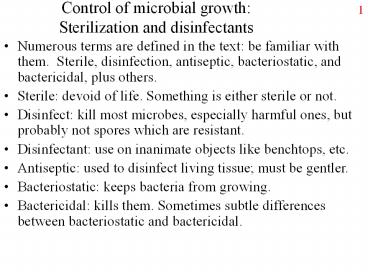Control of microbial growth: Sterilization and disinfectants - PowerPoint PPT Presentation
Title:
Control of microbial growth: Sterilization and disinfectants
Description:
Heavy metals: Hg, Ag, Se, Cu Used less; toxic and corrosive. ... explosive Acids and alkalis: often microbiostatic Acetic and lactic acids in foods; Benzoate, ... – PowerPoint PPT presentation
Number of Views:986
Avg rating:3.0/5.0
Title: Control of microbial growth: Sterilization and disinfectants
1
Control of microbial growthSterilization and
disinfectants
- Numerous terms are defined in the text be
familiar with them. Sterile, disinfection,
antiseptic, bacteriostatic, and bactericidal,
plus others. - Sterile devoid of life. Something is either
sterile or not. - Disinfect kill most microbes, especially harmful
ones, but probably not spores which are
resistant. - Disinfectant use on inanimate objects like
benchtops, etc. - Antiseptic used to disinfect living tissue must
be gentler. - Bacteriostatic keeps bacteria from growing.
- Bactericidal kills them. Sometimes subtle
differences between bacteriostatic and
bactericidal.
2
Kinetics of bacterial death
- Bacteria not only grow exponentially, but die
that way too. - Factors that affect the rate of death include
temperature, pH, concentration of disinfectant,
type of microbe, and presence of organic material.
The longer the treatment is applied, the more
that are killed. The more microbes there are, the
longer it will take.
3
The Ideal Disinfectant
- Fast and effective, even in the presence of
organic material (like blood, vomit, feces..) - Effective, but non-toxic to humans.
- Penetrate materials without damaging them.
- Easy to prepare and stable over time.
- Inexpensive and easy to apply.
- Not stink!
4
How do antimicrobial agents work?
- Attack proteins
- Oxidize, hydrolyze, or bind to proteins.
- Change 3-D structure, usually irreversibly ruin
protein. - Dissolve membranes or damages cell walls
- Leaky membranes means vitamins, metabolites,
escape - Proton gradient across membrane gone, little ATP
made. - Wall destroyed, loss of osmotic protection
- Damage to nucleic acids
- DNA denatured or broken, cell cant replicate
- RNA molecules in ribosomes affected
5
Microbes vary in susceptibility
- Bacterial endospores hardest of all to kill
- Resist high heat, dessication, chemicals,
radiation - Cysts of protozoa
- Resting cells of eukaryotes, similar to
endospores - Mycobacteria waxy cell wall provides resistance
- Gram negative bacteria more resistant than G
- Viruses some hard to kill, other easier
Disinfectants vary in effectiveness Not all
disinfectants work equally well against all
microbes. These differences can be measured in
different ways.
6
Disinfectants -1
- Halogens Cl, I, Br, Fl
- Chlorine Cl2 gas, hypochlorites (bleach), and
chloramines (NH2Cl) - I as tincture or as iodophors such as betadine.
- Phenols and phenolics
- O-phenyl phenol (Lysol), hexachlorophene,
trichlosan, chlorhexidine - Alcohols isopropanol, ethanol best at 70-95
- Good at removing lipids w/ attached bacteria from
skin - Weakly attacks proteins, cell membranes
phenol
7
Disinfectants -2
- Hydrogen peroxide and ozone
- H2O2, stored at 30, used at 3
- new plasma gas sterilizers read article
- Soaps and detergents cationic (Quats), anionic
- Soaps are alkaline salts of fatty acids, weak
- Quaternary ammonium compounds weak but useful.
- Mostly wash away microbes or damage membranes.
- Heavy metals Hg, Ag, Se, Cu
- Used less toxic and corrosive. Hg and Ag
historically
8
Disinfectants -3
- Alkylating agents
- Formaldehyde, glutaraldehyde (effective at high
pH) - Ethylene oxide common, toxic, explosive
- Acids and alkalis often microbiostatic
- Acetic and lactic acids in foods
- Benzoate, sorbic acid and propionate
- Other stuff
- Sulfites (control regrowth in wine), nitrites
(botulism or cancer?), various dyes (selective
growth media)
9
Physical methods
- Temperature
- Cold slows or prevents growth, may kill slowly
- Ultra-cold used to preserve bacteria long term
- Heat denatures enzymes, kills cells
- Moist heat
- Traditional pasteurization does not sterilize
- Standard protocols, time and temperature e.g.
62.9/ 30 min - flash pasteurization 71.6 / 15
- Newer UHT sterilizes 74-140-74 in 5
10
More on temperature
- Sterilizing boiling, autoclave
- Boiling will not necessarily kill endospores
- Autoclave is steam heat under pressure, so above
boiling - 121C, 19-21 psi. Very effective.
- Compare moist heat and dry heat
- Dry heat 170 deg C, near 350 F, for 2 hours
- Water conducts heat much more effectively,
sterilizes at lower temperature for shorter time. - Dry heat not useful for liquids!
- Incineration (e.g. flaming loop) has its place
too.
11
Physical methods-2
- Drying cells need water. Remove it, and no
growth. - Freeze drying lyophilization also used to
preserve cultures for long term storage. - Osmotic pressure/high salt
- Sucks water out of cytoplasm salted meat,
jellies, etc. - Radiation
- UV used to sterilize air, surfaces in hospitals,
etc. - Ionizing radiation x-rays (electron beam) and
gamma rays important treatment of plastics,
various foods. - Irradiation of meat important tool in food
safety. - Microwaves only boil ultrasonics used to break
cells.
12
Physical methods-3
- Filtration
- Membrane filtration thin plastic disks with
holes of 0.22 or 0.45 micrometers, separate
liquid from bacteria - Used to collect bacteria or sterilize liquids
- Solutions of vitamins or proteins can be
destroyed by heating - Air filtration HEPA filters used in hospitals
and also homes to help remove dust-borne
bacteria, allergens.































